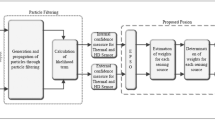Abstract
This paper deals with several new methodologies and concepts in the area of rough set theoretic granular computing which are then applied in video tracking. A new concept of neighborhood granule formation over images is introduced here. These granules are of arbitrary shapes and sizes unlike other existing granulation techniques and hence more natural. The concept of rough-rule base is used for video tracking to deal with the uncertainties and incompleteness as well as to gain in computation time. A new neighborhood granular rough rule base is formulated which proves to be effective in reducing the indiscernibility of the rule-base. This new rule-base provides more accurate results in the task of tracking. Two indices to evaluate the performance of tracking are defined. These indices do not need ground truth information or any estimation technique like the other existing ones. All these features are demonstrated with suitable experimental results.







Similar content being viewed by others
References
ChaLearn (2011) ChaLearn Gesture Dataset (CGD 2011). California
Chuanga KS, Tzenga HL, Chena S, Wua J, Chenc TJ (2006) Fuzzy c-means clustering with spatial information for image segmentation. Comput Med Imaging Graph 30(1)
Comaniciu D, Ramesh V, Meer P (2003) Kernel-based object tracking. IEEE Trans Pattern Anal Mach Intell 25:564–577
Davies DL, Bouldin DW (1979) A cluster separation measure. IEEE Trans Pattern Anal Mach Intell 1:224–227
Du Y, Hu Q, Zhu P, Ma P (2011) Rule learning for classification based on neighborhood covering reduction. Inf Sci 181(24):5457–5467
Heikkila M, Pietikainen M (2006) A texture-based method for modeling the background and detecting moving objects. IEEE Trans Pattern Anal Mach Intell 28:657–662
Hu Q, Yu D, Liu J, Wu C (2008) Neighborhood rough set based heterogeneous feature subset selection. Inf Sci 178(18):3577–3594
Janoch A, Karayev S, Jia Y, Barron JT, Fritz M, Saenko K, Darrell T (2011) A category-level 3-d object dataset: putting the kinect to work. In: ICCV Workshop on Consumer Depth Cameras for Computer Vision
Kanungo T, Mount DM, Netanyahu NS, Piatko CD, Silverman R, Wu A (2002) An efficient k-means clustering algorithm: analysis and implementation. IEEE Trans Pattern Anal Mach Intell 24(7): 881–892
Komorouski J, Pawlak Z, Polkowski L, Skowron A (1999) Rough sets: a tutorial. In: Pal SK, Skowron A (eds) Rough fuzzy hybridization: a new trend in decision-making. Springer, Singapore, pp 3–98
Lai K, Bo L, Ren X, Fox D (2011) A large-scale hierarchical multi-view rgb-d object dataset. In: ICRA. (pp. 1817–1824)
Maggio E, Cavallaro A (2010) Video tracking: theory and practice. Wiley, New York
Meher SK, Pal SK (2011) Rough-wavelet granular space and classification of multispectral remote sensing image. Appl Soft Comput 11(8):5662–5673
Mushrif MM, Ray AK (2008) Color image segmentation: rough-set theoretic approach. Pattern Recogn Lett 29(4):483–493
Pal SK, Ghosh A, Shankar BU (2000) Segmentation of remotely sensed images with fuzzy thresholding, and quantitative evaluation. Int J Remote Sens 21:2269–2300
Pal SK, Shankar BU, Mitra P (2005) Granular computing, rough entropy and object extraction. Pattern Recogn Lett 26:2509–2517
Pal SK, Chakraborty D (2013) Unsupervised tracking, roughness and quantitative indices. Fundam Inform (IOS Press) 124(1–2):63–90
Pawlak Z (1992) Rough sets: theoretical aspects of reasoning about data. Kluwer Academic Publishers, Norwell, MA
Pedrycz W, Song M (2014) A granulation of linguistic information in ahp decision-making problems. Inf Fusion 17:93–101
Sen D, Pal SK (2009) Generalized rough sets, entropy, and image ambiguity measures. IEEE Trans Syst Man Cyberns Part B 39:117–128
Sinthanayothin C, Wongwaen N, Bholsithi W (2012) Skeleton tracking using kinect sensor and displaying in 3d virtual scene. Int J Adv Comput Technol (IJACT) 4(11):213–223
Swirniaski RW (2001) Rough sets methods in feature reduction and classification. Int J Appl Math Comput Sci 11:565–582
Wang Q, Chen F, Xu W, Yang MH (2012) Object tracking via partial least squares analysis. IEEE Trans Image Proc 21(10):4454–4465
Yilmaz A, Javed O, Shah M (2006) Object tracking: a survey. ACM Comput Surv 38(4):1264–1291
Zadeh LA (1997) Toward a theory of fuzzy information granulation and its centrality in human reasoning and fuzzy logic. Fuzzy Sets Syst 90(2):111–127
Acknowledgments
S. K. Pal acknowledges the J. C. Bose National Fellowship, Government of India and Indian National Academy of Engineering (INAE) Chair Professorship.
Author information
Authors and Affiliations
Corresponding author
Rights and permissions
About this article
Cite this article
Chakraborty, D.B., Pal, S.K. Neighborhood granules and rough rule-base in tracking. Nat Comput 15, 359–370 (2016). https://doi.org/10.1007/s11047-015-9493-6
Published:
Issue Date:
DOI: https://doi.org/10.1007/s11047-015-9493-6




